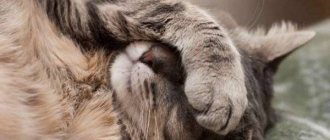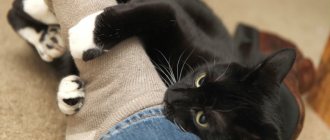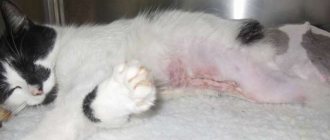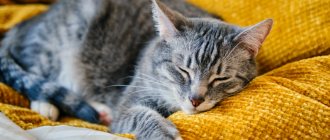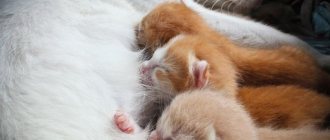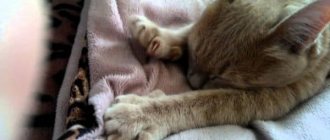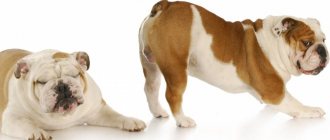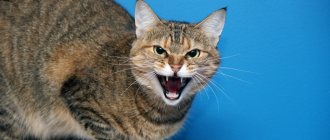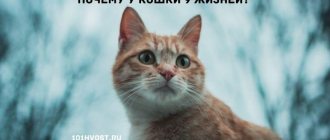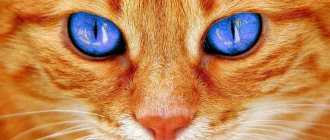What will you learn from the article?
- Symptoms of flatulence How to tell if your cat has gas
- Flatulence and other health problems
- Veterinary drugs for flatulence
- What foods should not be included in a cat's diet?
Flatulence in a cat (passage of gas) is a natural process in the functioning of the cat’s digestive system. Cats, like people and other pets, fart from time to time. However, excess gases in the intestines and their discharge, which is accompanied by foul odors, is not the norm. This is an alarm bell indicating gastrointestinal problems and a reason to contact a veterinarian.
How can you tell if your cat has flatulence? What are the reasons for this phenomenon? How to remove gas from a cat and how to prevent its occurrence? When do you need to take your cat to the doctor urgently? We will answer all these questions in our article.
Symptoms of flatulence
Loud sounds and unpleasant odors when a cat passes gas are the main symptoms of flatulence. However, this process is not always accompanied by a stench. Other signs may indicate problems with the digestive tract.
How to tell if your cat has gas
- The cat's stomach growls loudly.
- Pain in the stomach area. The cat won't let you touch its belly.
- Stomach bloating in a cat.
- The cat farts often.
- Hiccups.
- Diarrhea and gases suddenly released from the anus.
- Vomit.
- Muscle spasms in the abdominal area.
- The cat is worried and meows loudly and pitifully in pain.
- The animal hides and does not allow itself to be touched.
Bloating, vomiting, diarrhea and flatulence may indicate other problems with the animal's gastrointestinal tract. Take your cat to the veterinarian for a diagnosis and treatment.
Increased gas formation from dry food
When considering the described composition of ready-made dry food, cereal nutrients often come first. Considering the physiology of a cat, this is an undesirable component of food.
Statistics show that owners who organize feeding with dry food often turn to specialists for problems with flatulence. A natural diet or feeding canned food is more gentle on the cat’s digestive system, and flatulence occurs less frequently.
If the cat is on dry food, then the initial response to flatulence is to change the type of feeding. Translation should be carried out slowly, gradually, carefully.
Causes of flatulence
Excessive gas can be caused by a number of reasons, but the most common is the cat's poor diet. Pet owners should be careful about what their cat eats. Choose only good fresh foods and balanced, high quality feed.
Causes of flatulence in cats:
- Food allergies.
- A diet high in fiber and dairy products.
- Expired food and spoiled products.
- Swallowing food too quickly (aerophagia).
- Binge eating.
- Accumulation of bezoars (hairballs) in the cat’s gastrointestinal tract.
- Helminthic infestations.
- Insufficient physical activity.
- A sharp change in diet, switching to other types of food.
- Serious diseases of the gastrointestinal tract.
Flatulence and other health problems
In rare cases, the phenomenon of flatulence indicates serious problems with the cat's health.
Excessive gas formation due to large amounts of air swallowed during feeding (aerophagia):
- stomatitis;
- stress;
- hypersalivation (increased salivation);
- nasal congestion (runny nose in a cat);
- cardiovascular diseases.
Foul odor due to fermentation processes in the intestines:
- parasitic disease trichomoniasis;
- gastritis;
- inflammatory processes in the gastrointestinal tract;
- dysbacteriosis;
- bowel cancer.
Flatulence in a cat after birth, accompanied by bloating, may indicate serious postpartum complications and requires immediate attention from a veterinarian.
Flatulence in a kitten
If a kitten farts frequently and has a swollen belly, this most often does not require a visit to the veterinarian.
There are three main causes of flatulence in kittens:
- A sharp transition from mother's milk to another type of nutrition.
- Kittens suck milk greedily and quickly, competing with each other, so they swallow too much air.
- Kittens, when they first learn to lap and eat on their own, swallow food too quickly.
Important: a swollen belly in kittens is often due to infection with worms. Carry out antiparasitic treatment in accordance with your veterinarian's recommendations.
Do they fart or not?
Owners often have a question: “Can cats fart?” Cats fart, and this is a completely normal process of life. However, this happens very rarely. If your cat farts too often, you should pay attention to your pet's health.
During the digestion of food, gases are formed in the cat's intestines. Gases can also form in the stomach due to the action of carbohydrates. Unlike dogs, cats can form a sufficient amount of carbohydrates themselves. Therefore, their increased content in food can cause increased gas formation in the cat’s stomach.
When to urgently contact a veterinarian
Most often, excessive gas formation, frequent release of gases does not require the intervention of veterinary specialists.
A visit to the veterinarian is necessary if these symptoms are accompanied by others:
- bloody diarrhea;
- vomit;
- decreased appetite;
- complete refusal to eat;
- painful bloated stomach;
- restless cat behavior.
The doctor must examine the animal, give it the correct diagnosis, and prescribe the necessary treatment.
Diagnostics
The diagnosis of “flatulence” is made by a doctor in a veterinary clinic based on a study of the cat’s history, lifestyle, diet, and the presence of concomitant pathologies. The owner must be prepared to answer a number of questions about the type of food, brand of food, time of transfer from one type of food to another, and the volume of the daily portion.
Additionally, a number of diagnostic tests are carried out to exclude other diseases.
- Analysis of stool for parasite infestation.
- Blood analysis.
- X-ray of the abdominal cavity.
- Ultrasound of the intestines.
- Analysis of urine.
- Biopsy.
Remember the events that preceded the occurrence of a health problem, tell your doctor about them. Maybe the cat picked up something and ate it while walking outside, stole something from the table, or climbed into the trash can.
Treatment of flatulence in cats at home
Restoring your cat's digestion is the first thing to do when your veterinarian diagnoses flatulence. Treatment is usually carried out on an outpatient basis, and cats quickly return to normal.
It is important to correctly determine the cause of increased gas formation.
The treatment regimen and prescription of medications and procedures will depend on the cause of flatulence:
- If internal parasites are the cause of bloating, your doctor will prescribe a course of antiparasitic treatment. Medicines for worms should be prescribed by a veterinarian depending on the type of parasites and the degree of infestation.
- An assessment and review of the diet is necessary if the cause of gas in a cat is an incorrect diet, a sudden change in the type of food, or a transition to a new brand of food.
- If the cause is intestinal disease, therapy will be aimed at eliminating these pathologies.
- Increased gas formation due to too rapid absorption of food can be eliminated by the owner at home without medication. Cats living together should be fed separately to avoid competition over food. The problem of rapid feed absorption is solved by automatic feeders with dispensers. Placing ping pong balls in the food bowl will cause your cat to slow down when eating.
Veterinary drugs for flatulence
Medicines can be given to animals only after a diagnosis has been established as prescribed by a veterinarian.
To treat flatulence use:
- Carminatives – espumizan, simethicone.
- Adsorbents – activated carbon, polysorb.
- Painkillers – antipyrine, traumeel.
- Preparations for normalizing intestinal microflora - lactoferon, bifitrilak, enterol, zoonorm.
- Detoxifying agents – engystol, liarsin.
- Antidiarrheal drugs – bismuth subsalicylate.
Prevention
Preventive measures should be aimed at preventing the causes of increased gas formation.
Preventive actions:
- Adjusting the diet, switching to food with less fiber.
- Gradual transfer to another type of nutrition.
- Gradual introduction of a new brand of food.
- Reducing the volume of a single portion while increasing the frequency of feeding.
- Encouraging your pet's active lifestyle.
- Eliminate competition during feeding.
- Create a quiet, isolated environment for each animal to eat.
- Switch to high-protein brands of food with a low percentage of carbohydrates.
- Keep garbage out of reach of cats.
- Self-walking ban. Controlling what your cat picks up on the street.
- Excluding foods that cause increased gas formation from the cat's diet.
- To prevent the accumulation of bezoars in the cat's intestines, regularly feed the animal malt paste.
- Follow your veterinarian's recommended deworming schedule.
What foods should not be included in a cat's diet?
Eliminate these foods from your cat's diet to prevent flatulence.
- Milk. One of the most common misconceptions about cat nutrition is that they all need to drink milk. This is wrong! Many cats are lactose intolerant. Milk intolerance in cats increases with age. Milk can cause stomach upset and excessive gas build-up in your pet's intestines.
- Dairy products. Cheeses, cottage cheese, sour cream, yogurt, kefir can cause flatulence, since the cat’s body is not able to properly process and assimilate such complex products.
- Canned fish. Canned tuna and other fish can cause serious health problems for your pet, including poisoning. Canned fish causes the smell of animal urine and feces to change to unpleasant.
- Garlic. Garlic is famous for its excellent anthelmintic effect, but it should not be given to cats in any form. Garlic can cause a number of health problems for your cat, so avoid getting it in your pet's food.
- Cereal products. Do not forget that cats are carnivores and they should eat mainly meat. A diet high in wheat, corn and soy is irritating to cats' digestive systems and is very difficult to digest.
- Fat and fatty foods. Cats should eat lean meat, not fat trimmings. Therefore, no fat in your pet’s diet, because fatty foods cause indigestion and flatulence.
- Bread and bakery products. Yeast, which is found in baked goods, is also dangerous to the health of cats. Yeast causes fermentation and excessive gas production, which distends the cat's stomach.
- Food that has expired. Avoid feeding your cats table scraps and especially stale food. What can harm your health will also harm the health of your pet.
Problems with increased gas formation in most cases can be solved by reviewing the diet and diet, as well as being careful about what the cat eats. But if gas has become a chronic problem and is causing discomfort and suffering to your animal, do not delay a visit to the veterinarian.
Sources:
- https://www.thesprucepets.com/why-do-cats-fart-554763
- https://pets.webmd.com/cats/cat-flatulence-gas#1
- https://www.hillspet.com/cat-care/healthcare/do-cats-fart
- https://www.petcoach.co/cat/condition/flatulence/
The structure of the digestive system
The digestive system of cats consists of the oral cavity, pharynx, stomach, small and large intestines. The pancreas, duodenum and gallbladder also take part in the digestion process.
An adult cat has 30 teeth in its mouth. The tongue is covered with small, rough papillae, thanks to which the cat can lap up all sorts of liquids. Thanks to saliva, the digestion process begins in the oral cavity. Next, the cat pushes food into the esophagus, which can stretch if necessary.
The food then enters the stomach, where it is digested with the help of gastric juice. From the stomach, food enters the small intestine, where it is finally digested with the help of a pancreatic enzyme.
The processed compressed waste is excreted through the large intestine. It also serves to form beneficial microorganisms and bacteria.
